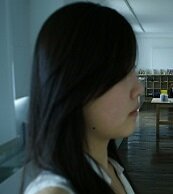An artist Lee Ji Sun’s art life of research, ‘About the point’ 작가 이지선의 예술 탐구생활, “점에 관하여”

A Sunday Afternoon on the Island of La Grande Jatte(Oil on canvas, 1886) – Georges Seurat(image from www.artble.com)
Images & Texts by Lee Ji Sun
A small drop of black ink marked on a white sheet fills the entire space which seemed to be empty and holds people’s attention. Regardless of its own color and form, once positioned on the surface, it is called ‘the point’.
Point is a virtual element of geometry which doesn’t have any dimensional attribute but only a position. It is the first element of all forms: it draws a stroke moving from a departing place to another stop, then constitutes various planes and volumes.

Textworld(video, 2012) – JiSun LEE
As component of symbols or signs, the point defines punctuations and meanings of different languages. In Hanja (logographic Chinese characters), significations often refer to their graphics (graphical depiction of the object or ideographs for abstract notions) : for example, a point above the horizontal line makes 上 (shàng “up”), and the opposite makes下(xià “down”). In alphabet as well, there is ‘i’, lowercase of the ninth letter with dotted forms to which I cling in my video works.
Imaging footsteps on the ground covered in white snow, or Hansel and Gretel’s dropped crumbs, points also stay in number of two, three or more. Then they end a sentence, represent the silent air, or indicate passable borders.

石本無聲(석본무성) (The silent stone, ink on paper, 2013) – 김대열 Dae-Yeol Kim(image from www.artmail.co.kr)
East Asian paintings (called Shan Shui or Sansui) depict natural scenery with spatial points using brush and ink. The expression ‘spatial point’ may sound contradictory, but it becomes a physical and potential space itself as the watered ink flows into the paper. Splashed water marks and fallen ink drops from the edge of the brush, or strong traces of artist’s arm power… According to different conditions such as ink shading or paper texture, the point figures simple but intense, empty but complete forms on the paper.

Timeworld(video, 2013) – JiSun LEE
In Western paintings, the composition consists of playful arrangements with other geometrical forms on the surface. Many impressionists filled rectangular canvas with uncountable touches of colors which reflect the artist’s brush-stroke and aging paintings. Overlaid dots attract viewers’ eyes and present certain landscape or human figures. Russian abstract painter and art theorist Wassily Kandinsky considered the point not only as a simple geometric or mathematical element, but as extensible form and color by itself. So he approached it in multiple angles and represented it in complex forms, more than just a circle.

Free Curve to the Point – Accompanying Sound of Geometric Curves(ink on paper, 1925) – Wassily Kandinsk(image from www.metmuseum.org)
The points appear through further and larger variety of understandings in postmodern art. Some fill out all visible surfaces with colorful dots, some make fantastic stages of dancing points in the videos. Often borrowing appearance of circles and spheres, on flat canvas or in multidimensional spaces, the point puts the center of gravity, stops a time-flow, wakes up the sleeping things, starts or ends a story. As the giant sun shining all over the world is also a tiny spot in the universe, the smallest point situates us in the largest and deepest world and leads us to look at the present in endlessly passing time.
Lee Ji Sun is a young Korean artist, who does activity in Paris, France. CultureM Magazine releases her art works images by drawing, writing, video, photograph in every month. http://leejisun.blogspot.kr/
이지선은 프랑스 파리를 중심으로 유럽에서 활동하는 젊은 한국여성작가이다. 회화, 비디오, 사진, 글 등의 다양한 매체로 작품활동을 하고 있는 그녀의 이야기를 컬쳐엠이 소개한다. http://leejisun.blogspot.kr/
















Comments are closed